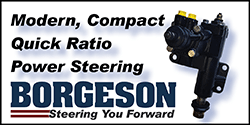I will be no help with gears or tires recommendations.
They made two different wheelbases for FMJ bodies:
All 4-doors, station wagons and J-body - 112.7”
All F and M-body 2-doors – 108.7”
The “Tread” (center of tire to center of tire) is the same on all FMJ vehicles – which is 60.0” front and 58.5” rear.
The front and rear suspension is exactly the same on all 1976-1989 F, M and J bodies (K-frames, control arms, spindles, torsion bars, sway bars, leaf springs and differentials).
Police vehicles and station wagons should have (but not necessarily true in all cases) 5-leaf rear springs.
Police vehicles (not necessarily true in all cases) have larger diameter front sway bars as well as have rear sway bars (the only FMJ vehicles I know of that came with them, factory).
For racing, aftermarket front/rear sway bars would be better – if rules permit. The rest should work pretty well, as is.
More Camber can made either way. The easier way is by ride height (higher allows more in one direction, lower, the other way).
To get more Positive camber, you can add thick spacers between the K-frame and the upper plate (the “L” shaped plate between the K-frame and upper control arm. 1/8” thick spacers should give a person more positive Camber than one will use – but if not add thicker spacers. Once added – no one can even tell they are there.
Negative Camber will require the alignment adjustment slots to be lengthen towards the engine. A person might want to find spare plates, weld more onto it (engine side) and then lengthen the slots.
Once cut on and/or welded on, I would recommend getting the modified plates heat treated, for dirt racing. Even if you didn’t weld to it and only lengthen the slots for more Negative Camber, once you cut the steel, and set the plates out in the rain a couple of times – it would be hard to know if the lengthened slots came that way, or not.
The aftermarket makes (weld-on) lower control arm plates – that will help stiffen the LCA’s (lower control arms) – which I recommend.
A person could use a 7¼” differential – but I would not for a number of reasons (except for in case of a spare).
The 8¼” is more suited for this kind of racing and has a lot more gear ratios available for it.
FMJ's only came out with 7¼” and 8¼” differentials.
The best differential for this kind of racing would be a ’65-70 B-body 8¾”, which will bolt right in, no modifications (except for driveshaft length). That differential has a HUGE assortment of gear ratios – which can be changed-out trackside without too much work (if needed). The above mentioned 8¾” would be a “stock” part (but made a few years before your car was).
BudW
















